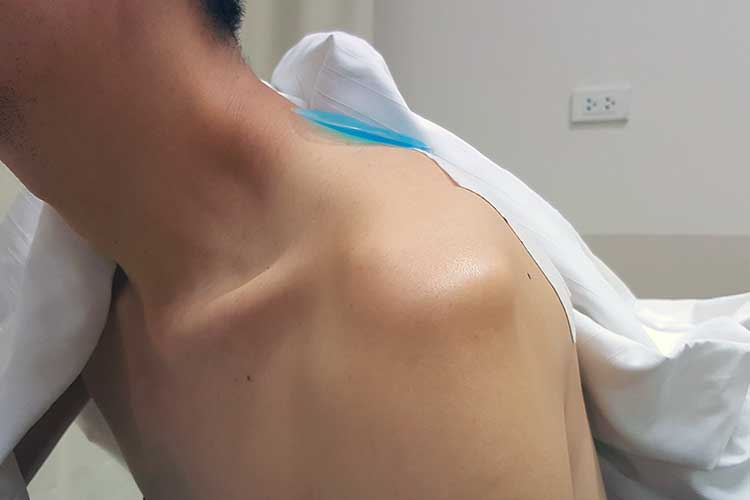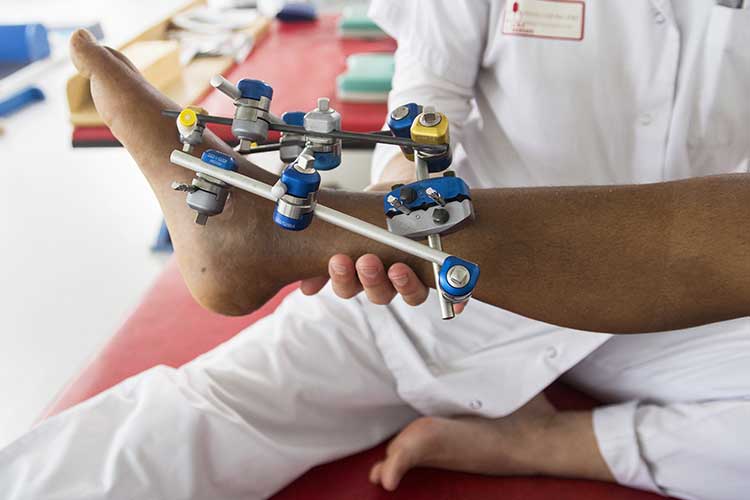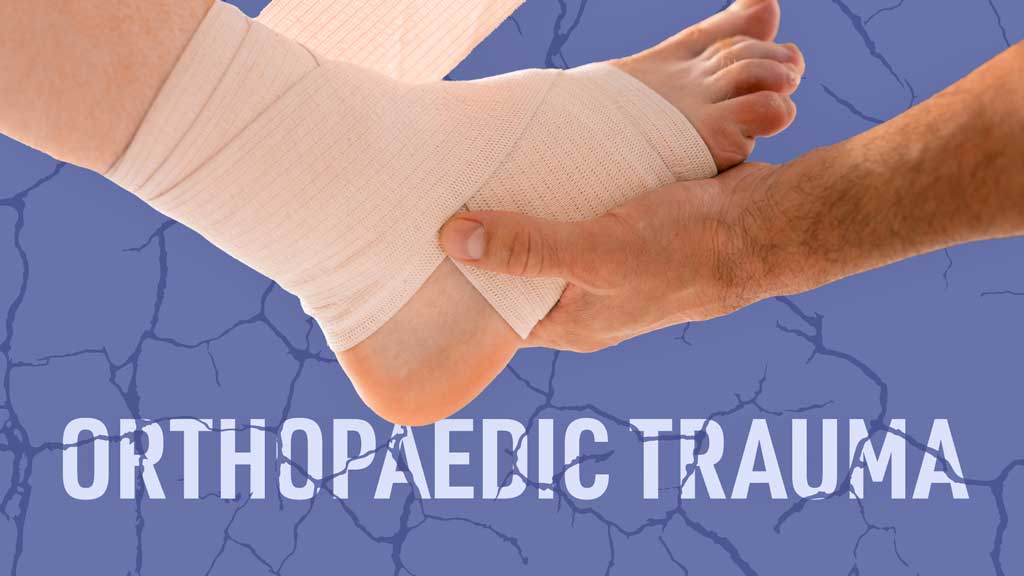Orthopaedic trauma can occur to anybody at any time (Orthopaedic Associates 2018).
According to data from the Australian Institute of Health and Welfare, it’s the most common type of injury resulting in hospitalisation.
Among the 538,000 (approximately) injury-related hospitalisations that occurred between 2021 and 2022 (AIHW 2023a):
- Bone fractures accounted for 206,602
- Dislocations accounted for 11,339
- Soft-tissue injuries accounted for 52,476.
(AIHW 2023b)
This article will provide a broad overview of orthopaedic trauma and why it occurs.
What is Orthopaedic Trauma?
The term orthopaedic trauma refers to injuries to organs or tissues in the musculoskeletal system, which includes:
- Bones
- Joints
- Muscles
- Tendons
- Ligaments
- Cartilage
- Any related tissues and vessels.
(COSSM 2020)
Types of Orthopaedic Trauma
Orthopaedic trauma can range in severity from a minor muscle strain to a potentially life-threatening injury (Better Health Channel 2022).
Categories of injury that fall under the umbrella of orthopaedic trauma include:
- Dislocations
- Fractures
- Breaks
- Sports hernia
- Impingement
- Overuse injuries
- Sprains.
(Beaumont 2018)
There are numerous types of specific orthopaedic injuries, but among the most common are:
- Sprained ankle or foot
- Anterior cruciate ligament (ACL) injury
- Meniscus tear
- Plantar fasciitis
- Dislocated shoulder
- Rotator cuff tear
- Tennis elbow
- Carpal tunnel syndrome
- Wrist fracture
- Stress fracture.
(COSSM 2019)

Causes of Orthopaedic Trauma
Orthopaedic trauma may be caused by:
- Acute trauma - a sudden injury, for example:
- Motor vehicle accidents
- Sport injuries
- Falls
- Physical violence
- Natural disasters
- Chronic trauma - the application of repetitive motion or force, causing an injury to occur over time
- Degenerative change - wear and tear that occurs with age.
(Lloyd & Lewis 2020; Cooper 2020)
Risk Factors For Orthopaedic Trauma
- Osteoporosis
- Age, as bones naturally lose density as part of the ageing process, making them more prone to breakage
- Older women are particularly at risk - half of all women over 50 will experience a bone fracture, compared to one-third of men over 50
- Being an Aboriginal and Torres Strait Islander person
- Living in a very remote area
- Living in a lower socioeconomic area
- Being overweight or obese, which puts increased pressure on the musculoskeletal system
- Playing sport
- Smoking
- Alcohol consumption, which can affect bone structure and mass
- Heavy use of corticosteroids
- Certain chronic conditions, including rheumatoid arthritis, diabetes, coeliac disease, Crohn’s disease and ulcerative colitis
- Previous bone fracture
- Occupations that involve repetitive movements, increasing the risk of strains
- Improper manual handling techniques.
(Lewiecki 2024; Hendrie 2021; AIHW 2023a; Beaumont 2018; American Bone Health 2020; Lloyd & Lewis 2020; Brennan-Olsen et al. 2017)
Symptoms of Orthopaedic Trauma
Depending on the type of injury, these may include:
- Pain (may be sharp, dull, aching, cramping, stabbing or burning)
- Redness
- Warmth
- Bruising
- Swelling
- Tenderness
- Numbness
- Stiffness
- Reduced range of motion
- Difficulty bearing weight on the affected area
- Bleeding
- Deformity (e.g. a limb looking out of place)
- Numbness or tingling
- Weakness in the affected area
- Muscle spasms
- Fatigue.
(Lloyd & Lewis 2020; COSSM 2020; Throckmorton 2021)
Diagnosing Orthopaedic Trauma
Depending on the injury, diagnostic methods may include:
- Arthrography
- Bone scans
- Computed tomography (CT Scan)
- Doppler ultrasound
- Dual-energy X-ray absorptiometry (DEXA)
- Electromyography (EMG)
- Intrathecal contrast-enhanced CT scan
- Joint aspiration and analysis
- Laboratory studies of blood, urine or synovial fluids
- Magnetic resonance imaging (MRI)
- Muscle tests
- Nerve conduction study (NCS)
- Palpation
- Physical examination
- Quantitative computed tomography
- Range of motion tests
- Venography
- X-ray.
(Apollo Hospitals 2020)
Treating Orthopaedic Trauma

Treatment varies and may be surgical or non-surgical depending on the specific type of injury sustained and its severity (Mount Sinai 2020).
Generally, the common goals of treating orthopaedic trauma are:
- Correcting any physical problems
- Alleviating symptoms
- Improving the patient’s quality of life
- Preventing further problems from occurring in the future.
(Lloyd & Lewis 2020)
Specific treatments might include:
- An external fixation device (e.g. metal screws, pins, rods or plates)
- Arthroplasty (replacement of a whole joint)
- Corrective surgery (e.g. realignment)
- Cast immobilisation
- Functional cast or brace
- Traction
- Physical therapy
- Analgesic medicines
- RICE (rest, ice, compression and elevation)
- Rest.
(NHS 2023; Throckmorton 2021; COSSM 2019)
Some injuries, such as stress fractures, might heal on their own (COSSM 2019).
Complications of Orthopaedic Trauma
In some cases, orthopaedic trauma might lead to complications or chronic issues such as:
- Nonunion fracture (a fracture that doesn’t heal)
- Delayed union fracture (a fracture that takes longer to heal than normal)
- Malunion fracture (a fracture that doesn’t heal in the correct alignment)
- Joint deformity
- Infection.
(Mount Sinai 2020; Henry Ford Health System 2016)
Potential signs of complication include:
- Chronic pain
- Wound drainage
- Fever
- Swelling
- Limping.
(Henry Ford Health System 2016)
Complications should be referred to an orthopaedic specialist for treatment (Henry Ford Health System 2016).
Preventing Orthopaedic Trauma
The risk of experiencing orthopaedic trauma can be reduced through measures such as:
- Always wearing a seatbelt
- Always wearing a helmet when riding a bike, skateboarding, rollerblading, etc.
- Wearing appropriate safety gear when playing sport
- Stretching and warming up before exercising or playing sport
- Using proper manual handling techniques
- Maintaining a healthy lifestyle
- Avoiding smoking
- Wearing comfortable, low-heeled shoes to reduce the risk of tripping or slipping
- Using night lights to prevent tripping in the dark
- Removing clutter
- Keeping bones healthy and strong through weight-bearing exercise (e.g. walking) and increasing balance through exercises that build muscle
- Ensuring adequate intake of calcium and vitamin D.
(Cooper 2020; Cleveland Clinic 2022; Lloyd & Lewis 2020)

Test Your Knowledge
Question 1 of 3
Which one of the following terms describes a bone fracture that has healed in an abnormal alignment?
Topics
References
- American Bone Health 2020, Fracture Risk Factors, American Bone Health, viewed 16 January 2024, https://americanbonehealth.org/fracture/fracture-risk-factors/
- Apollo Hospitals 2020, 20 Tests That Evaluate Your Bone & Joints Health, Apollo Hospitals, viewed 16 January 2024, https://www.apollohospitals.com/events/20-tests-that-evaluate-your-bone-joints/
- Australian Institute of Health and Welfare 2023a, Injury in Australia, Australian Government, viewed 16 January 2024, https://www.aihw.gov.au/reports/injury/injury-in-australia/contents/introduction
- Australian Institute of Health and Welfare 2023b, Injury in Australia: Data Tables A: Injury Hospitalisations, Australia, 2021–22, Australian Government, viewed 16 January 2024, https://www.aihw.gov.au/reports/injury/injury-in-australia/data
- Beaumont 2018, Common Orthopedic Injuries, Beaumont, viewed 16 January 2024, https://www.beaumont.org/conditions/common-orthopedic-injuries
- Better Health Channel 2022, Bone Fractures, Victoria State Government, viewed 16 January 2024, https://www.betterhealth.vic.gov.au/health/conditionsandtreatments/bone-fractures
- Brennan-Olsen, S L et al. 2017, ‘Fractures in Indigenous Compared to Non-Indigenous Populations: A Systematic Review of Rates and Aetiology’, Bone Reports, vol. 6, viewed 16 January 2024, https://www.ncbi.nlm.nih.gov/pmc/articles/PMC5437735/
- Center for Orthopaedic Surgery and Sports Medicine 2019, The 10 Most Common Orthopedic Injuries, COSSM, viewed 16 January 2024, https://www.centerfororthosurgery.com/the-10-most-common-orthopedic-injuries/
- Center for Orthopaedic Surgery and Sports Medicine 2020, What is Considered an Orthopedic Trauma?, COSSM, viewed 16 January 2024, https://www.centerfororthosurgery.com/what-is-considered-an-orthopedic-trauma/
- Cleveland Clinic 2022, Bone Fractures, Cleveland Clinic, viewed 16 January 2024, https://my.clevelandclinic.org/health/diseases/15241-bone-fractures
- Cooper, S 2020, What is Orthopaedic Trauma? Definition, Treatment, and Prevention, Florida Medical Clinic, viewed 16 January 2024, https://www.floridamedicalclinic.com/blog/what-is-orthopaedic-trauma/
- Hendrie, D 2021, ‘Fractures Can be Deadly. Why is Preventive Action Rare?’, newsGP, 10 February, viewed 16 January 2024, https://www1.racgp.org.au/newsgp/clinical/fractures-are-linked-to-deaths-in-older-people-why
- Henry Ford Health System 2016, Bone Healing Complications, Henry Ford Health System, viewed 16 January 2024, https://www.henryford.com/services/orthopedics/broken-bones-trauma/complications-healing-bones
- Lewiecki, EM 2024, Osteoporotic Fracture Risk Assessment, UpToDate, viewed 16 January 2024, https://www.uptodate.com/contents/osteoporotic-fracture-risk-assessment
- Lloyd, WC & Lewis, S 2020, Orthopedic Conditions, Healthgrades, viewed 16 January 2024, https://www.healthgrades.com/right-care/bones-joints-and-muscles/orthopedic-conditions
- Mount Sinai 2020, Orthopedic Trauma, Mount Sinai, viewed 16 January 2024, https://www.mountsinai.org/care/orthopedics/services/orthopedic-trauma
- National Health Service 2023, Trauma and Orthopaedic Surgery, NHS, viewed 16 January 2024, https://www.healthcareers.nhs.uk/explore-roles/doctors/roles-doctors/surgery/trauma-and-orthopaedic-surgery
- Orthopaedic Associates 2018, What Constitutes Orthopedic Trauma, Orthopaedic Associates, viewed 16 January 2024, https://www.oaidocs.com/2018/04/13/constitutes-orthopedic-trauma/
- Throckmorton, TW 2021, Fractures (Broken Bones), OrthoInfo, viewed 16 January 2024, https://orthoinfo.aaos.org/en/diseases--conditions/fractures-broken-bones/
 New
New 
